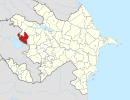Gadabay District
Gadabay District | |
|---|---|
UTC+4 (AZT) | |
| Postal code | 2100 |
| Website | gedebey-ih |
Gadabay District (
Etymology
The former name of Gadabay was Getabak.[4] The Armenian historian of the XIII century Vardan Areveltsi mentions the toponym in the form Getabaks.[4]
German philologist Heinrich Hübschmann hypothesized the toponym comes from the Armenian "get" (գետ) - river and "bak" (բակ) - yard.[4]
Geography
In west Azerbaijan's border upon Armenia stretches for a distance of 123 kilometres (76 mi).
Gadabay District is located in a zone of midlands and highlands of the
The highest heights are Goshabulag (3549m), Godzhadagh (2217m) and Garaarkhadzh (3549m).
The drainage of the district is significantly poor. Akhinja, Zayam and Shamkir are the largest rivers. Mountain-forest, mountain-meadow and other grounds spread here. Mountain shrubland and rare forest meadows in midlands, broad-leaved forests, subalpine and alpine meadows at the top of mountains occupy the greatest territory of the district.
Depositions of the Jurassic, Paleogene, Quaternary and other periods cover the surface of district. Gadabay district is rich of its underground resources such as gold, uranium, copper and other mineral resources. Goldfield in Soyudlu was explored by the Siemens brothers until arrival of Red Army soldiers in 1920.[5][6] At present there is opened a factory producing gold, where work about 2000 workers. Gadabay District is also famous for its mineral waters, such as “Narzan”, “Mor-Mor”, “Chaldash”, “Turshsu” and “Soyudlu narzani” (in Soyudlu village).
Gadabay is within the middle and high mountain ranges of the Small Caucasus. The region of Gadabay covers the northern incline of the Shahdagh Ridge, the Bashkand-Dastafur basin and some part of the Shamkir mountain range. Goshabulak (3549 m.), Gocadagh (3317 m.) and others are the highest peaks. Within the area Jurassic, Tabashir, Paleogene and Anthropogenic sediments are spread. There are black and white marble stones. Summer is dry and there is mild heat and in the winter there is a dry mountainous tundra climate. The waterway network is tight. The Akhyncachay and Zayam waterways stream through this region. Within the south-western border of the area, the upper stream of Shamkirchay flows through. Gray mountain forest, meadow soils are spread. The region contains a well-known Red State Nature Reserve and four natural monuments - Govdu, Godakdara, Gamish and Shamlik. There is a beautiful waterfall at Kechidarasi cliff. Goat, sparrows, roe deer and Ayubbulaq as well as Chaldash, Gizilca Narzan, Mor-Mor mineral water springs can also be observed. Within the mountains, in the forests and valleys of the locale, animal and plant life is very rich. Gadabay locale is in the middle and high mountain ranges of the Small Caucasus. The district is located in the northern part of the Shahdagh ridge, the Bashkend-Dizafur depression and the Shamkir mountain range.[7]
History
As the administrative unit Gadabay District was originated on August 8, 1930, under the name of Rustam Aliyev. In 1938, it was renamed to Gadabay District.
In July 2020, Gadabay became a site for the
Geological structure
Jurassic, Tabashir, Paleogene and Anthropogenic sediments are spread. The granite-rich metamorphic rocks, Gadabayit, was first studied in Gadabay Copper-Cholerite bed (1903).
Rivers and water basins
The waterway network is tight. Gadabay is rich in minerals and table water springs such as Mormor, Turshsu, Koroglu, Prince, Narzan, Big Bulak and others. The main waterways are Akimca, Zayam, Inakbogan, Mamasen, Shamkir, Gadabay Cahri and others.
Population
| 2000 | 2001 | 2002 | 2003 | 2004 | 2005 | 2006 | 2007 | 2008 | 2009 | 2010 | 2011 | 2012 | 2013 | 2014 | 2015 | 2016 | 2017 | 2018 | 2019 | 2020 | 2021 | |
| Gadabay region | 87,1 | 88,0 | 88,5 | 89,1 | 89,9 | 90,6 | 91,4 | 92,1 | 92,8 | 93,6 | 94,2 | 95,0 | 95,4 | 96,0 | 96,8 | 97,6 | 98,4 | 99,2 | 99,8 | 100,4 | 100,9 | 101,1 |
| urban population | 8,7 | 8,8 | 9,0 | 9,2 | 9,4 | 9,7 | 9,8 | 9,9 | 10,0 | 10,2 | 10,1 | 10,6 | 11,0 | 11,2 | 11,3 | 11,4 | 11,6 | 11,6 | 11,7 | 11,7 | 11,7 | 11,7 |
| rural population | 78,4 | 79,2 | 79,5 | 79,9 | 80,5 | 80,9 | 81,6 | 82,2 | 82,8 | 83,4 | 84,1 | 84,4 | 84,4 | 84,8 | 85,5 | 86,2 | 86,8 | 87,6 | 88,1 | 88,7 | 89,2 | 89,4 |
Demographics
Ethnic groups
- Azerbaijanis 99.29%
- Other 0.71% (mostly ethnic Russians, some of whom belong to the Molokan and Doukhobor religious minorities, living in villages such as Slavyanka)
Religion
- Muslim99.9%
- Other 0.1%
Language
- Azerbaijani Language99%
- Russian 0.9%
- Other 0.1%
References
- ^ "İnzibati-ərazi vahidləri" (PDF). preslib.az. Retrieved 28 February 2021.
- ^ "New head of Gedabey region appointed". www.turan.az. 2022-08-11.
- ^ a b "Population of Azerbaijan". stat.gov.az. State Statistics Committee. Retrieved 22 February 2021.
- ^ a b c Hübschmann, Heinrich (1904). Die Altarmenischen Ortsnamen. Mit Beiträgen zur historischen Topographie Armeniens und einer Karte. Verlag von Karl J. Trübner. p. 418.
- ^ "German industrialists' legacy to be revived in Azeri region". azernews.az. February 11, 2011. Archived from the original on 2013-01-15.
- ^ "Second plant in prospect at Azerbaijan gold mine". news.az. Archived from the original on 2014-08-21.
- ^ "Coğrafi mövqeyi - GƏDƏBƏY RAYON Icra Hakimiyyəti". www.gedebey-ih.gov.az. Retrieved 2018-11-23.
- RFE/RL. Archivedfrom the original on 5 August 2020. Retrieved 5 August 2020.
...the border between Armenia's northern Tavush province and the Tovuz district in Azerbaijan, the scene of the clashes.
- ^ Political division, population size and structure: Population by towns and regions of the Republic of Azerbaijan. "Population | The State Statistical Committee of the Republic of Azerbaijan". The State Statistical Committee of the Republic of Azerbaijan. Retrieved 2018-11-23.

